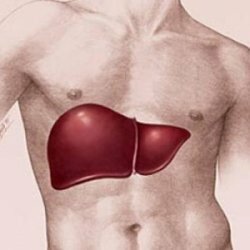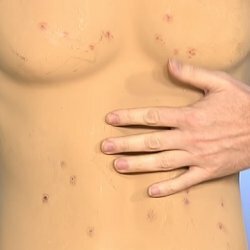Erysipelas: Clinic, Diagnosis, Treatment and Prevention
 Erysipelas, or erysipelas, is a serious infectious disease. Externally, it manifests itself as a progressive lesion of the skin. The very word "mug" came to us from the French root rouge, in translation the word means "red".From this article you will learn how to defeat erysipelas, a clinic, diagnosis, treatment and prevention of which are described below.
Erysipelas, or erysipelas, is a serious infectious disease. Externally, it manifests itself as a progressive lesion of the skin. The very word "mug" came to us from the French root rouge, in translation the word means "red".From this article you will learn how to defeat erysipelas, a clinic, diagnosis, treatment and prevention of which are described below.
The disease is quite common. It is on the fourth place after intestinal diseases and ARI, viral hepatitis. Often it affects people of the older group. From 20 to the age of thirty disease affects mostly men, especially those who are constantly forced to often traumatize the skin and contaminate it, and work at sharp temperature drops. The risk group includes drivers, military men, loaders and builders. At an older age, erysipelas are more likely to affect women. They occur on the limbs, less often in the face area, almost never on the trunk, genitals and perineum. Inflammations are noticeable to others, so the patient often feels discomfort and psychological depression.
Rozsa: the causes of disease
in the skin, intertrigo damaged, scratches, bruises and abrasions penetrate streptococcus - and this is the cause of this disease.
Approximately 15 percent of people, being carriers of the disease, do not suffer from it at all, because it does not manifest itself at all. In order for the disease to make itself felt, certain conditions must arise.
Conditions for the development of the disease:
- injuries, bruises;
- insolation( in a different way sunburn);
- stress;
- sudden temperature changes( overheating and overcooling);
- violations of cutaneous integrity( abrasions, cracks, intertrigo, scratches, scratching, nyxes).
The erysipelas can appear and against a background of some diseases which have to development of this illness. This fungus feet, and alcoholism, and diabetes and varicose veins, and obesity, and the problem with the vessels of the lymphatic system( lymphostasis), and foci of chronic streptococcal infection Plan( otitis, tonsillitis, periodontitis, tooth decay, trophic ulcers, thrombophlebitis).To provoking diseases include chronic somatic diseases, which reduce immunity. This happens, mainly, with the elderly.
As you know, streptococci are quite resistant to different conditions, they are widely represented in nature. The incidence increases in summer and fall. Sources of infection can become both sick people and carriers, not knowing about it.
Erysipelas:
clinic erysipelas classify:
based on local changes:
- erythematous,
- bullous-hemorrhagic,
- erythematous-bullous,
- erythematous-hemorrhagic.
on the basis of manifestations and their severity:
- is light,
- is medium-heavy,
- is heavy.
on frequency and multiplicity of manifestations of the disease:
- primary,
- recurrent,
- repeated.
on prevalence of affected areas:
- common,
- localized - limited.
When starting to develop the disease, the patient feels chill, it weakens, there is pain in the muscles, often vomits or vomiting, heart rate quickens. The temperature rises to a level of 40 degrees. If the case is heavy, then there is delirium, cramps. One day after the onset of the disease, a local picture appears: the affected area of the skin burns, it turns red, swells, it hurts, tension is observed in it. Local manifestation with this disease can appear on the face, on the trunk, on the mucous membranes.
Erysipelas: Diagnosis
Diagnose erysipelas due to clinical symptoms. Analyzes carried out laboratory, show the development of bacterial infection. As a rule, do not conduct a specific type of diagnosis in order to identify the causative agent of the disease.
Erysipelas: treatment with
From this disease, basically, get rid of in an outpatient setting. If the case is severe and purulent necrotic complications develop, frequent relapses occur, if the patient is very old or is a newborn baby, hospital treatment is recommended.
The patient is prescribed a course of antibiotics, which belong to the cephalosporin series of 1 and 2 generations, macrolides, penicillins, fluoroquinolones. The course should last up to 10 days. Dosages should be medium-therapeutic.
Less effective drugs are nitrofurans, erythromycin, sulfonamides and oleandomycin.
If there are frequent recurrences of the disease, it is recommended to consistently assign 2 types of antibiotics belonging to different groups: first use beta-lactams, and then lincomycin.
Treatment of the pathogenetic plan includes the appointment of antihistamines, vitamins, the conduct of detoxification therapy.
If bullous form of erysipelas has developed, then it is necessary to perform opening of blisters, after which it is necessary to apply napkins impregnated with antiseptics. Ointments in such cases do not apply to avoid skin irritation. For topical application, use of topical preparations such as dermazine and bepantene is recommended.
For the suppression of skin manifestations, you can apply physiotherapy, including sessions of UV, UHF, paraffin.
Often with relapses of the disease, treatment with bicillin-5, retarpene( in muscle every 3 weeks) is prescribed. If the erysipelas persistently continue to give relapses, the patient is given injections within a couple of years. After the withdrawal of symptoms, the patient is often prescribed a course of antibiotics for a six-month period.
Erysipelas: prevention
For the prevention of this disease, you need:
- Prevent injury and foot wear,
- Treat diseases caused by streptococcus;
- Treatment of primary disease, which can become a push to develop erysipelas;
- Carry out pharmacological prophylaxis, using antibiotics of slow( prolonged) action, preventing streptococcus from developing in the body. This is important for those who relapse of erysipelas are constantly tormented. Funds must be taken for a long time, sometimes even up to a year. Only a specialist should make a decision for such prevention.



